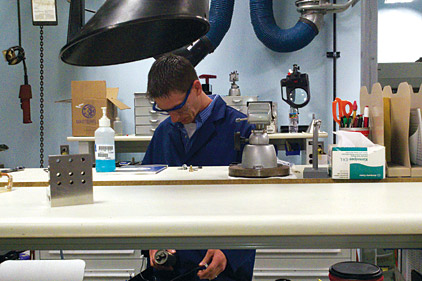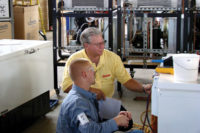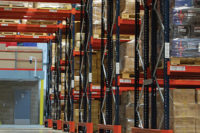
|
| Labs funded by the Department of Energy continue to invest time and resources into enhancing and creating current and future renewable HVAC technology. |
Better known for its role in the Manhattan Project, the Los Alamos National Laboratory (LANL) is a Department of Energy (DOE) facility that houses multiplescientific research projects. It is one among approximately 19 government labs across the Unites States that experiment with renewable energy sources, refrigerants, and HVAC technology, along with hundreds of other scientific topics. Each year the DOE petitions Congress with a “Congressional Budget Request” to continue financing the projects that show promise and are deemed worth pursuing. What has the DOE been up to in the name of renewable and HVAC?
Progress Report
According to the “Fiscal Year 2011 Summary of Performance and Financial Information” report released by the agency, the DOE is on track to complete energy-efficiency retrofits on 769,420 homes, resulting in an estimated annual energy savings of $437 per home retrofitted, by the end of fiscal year 2012. It also reported that U.S. renewable energy generation is expected to double from 71 terawatt-hours of generation from solar, wind, and geothermal in 2008 to 145 terawatt-hours of generation by 2012.
Within the DOE, the Office of Energy Efficiency and Renewable Energy (EERE) requested a $3.2 billion operating budget for fiscal year 2012, making clean renewable generation almost one-third of that budget. Projects like solar, wind, and geothermal were slated to have $457 million, $126.9 million, and $101.5 million operating budgets, respectively.
In the newly proposed budget, solar, wind, and geothermal continue to be among the top research investments being made by the government. These categories are surpassed by items such as vehicle technologies and building technologies. In observing the numbers, however, it appears that a stronger financial emphasis on solar energy is being placed than on wind energy or geothermal technology, even though the requested funding for these two categories is still considerable.
Emerging HVAC Tech
The EERE has been working to advance space conditioning and continues to push toward new goals with heat pumps, energy efficiency, non-vapor compression technologies with humidity control, retrofit technologies, application of nanotechnology to a/c component design, development of zero-global warming potential (GWP) refrigerants, etc.
One of the refrigerant ideas being experimented with is thermoacoustic refrigeration. Scientists have been working on the application of thermoacoustic refrigeration for decades and continue to make strides. Experiments in the late 80s showed promise and by the 90s many advances had been made.
The idea of thermoacoustic refrigeration was to use sound as opposed to any chemical refrigerant. If packaged correctly and efficiently, thermoacoustic refrigeration had the potential to be one of the first zero-GWP refrigerants. During its development, scientists ran into problems with the overall efficiency. Continued work brought improvements and in 1999, LANL scientists solved the efficiency problem and the U.S. Navy started showing an interest in this type of refrigeration for its submarines. The Navy was concerned about the heightened dangers of refrigerant leaks in these enclosed vessels.
In 2001, Pennsylvania State University (Penn State) scientists and Ben & Jerry’s Ice Cream partnered to create a thermoacoustic chiller. The goal for the green-aware ice cream maker was to end its dependence on HFCs and HCFCs and in 2004; the two entities introduced their working thermoacoustic chiller. The scientists from Penn State predicted that it would be another five to 10 years before finding its way into the mainstream market, but as of yet, it has not happened.
In 2006, students from Rutgers School of Engineering, Piscataway, N.J., replicated the work of previous scientists. According to their work, published by the school, they were “able to produce a small thermoacoustic refrigerator out of readily available parts. Combined with an understanding of the underlying thermodynamics, the model enables us to spread awareness of the viability of thermoacoustic devices as refrigerators and heat pumps.” (Read the entire paper here http://bit.ly/QGFb8B.)
The DOE’s current take on thermoacoustic refrigeration is a bit unclear, but experiments and research continue via EERE’s Building Technology Program (BTP), according to the 2012 fiscal year budget.
“BTP will identify Not-In-Kind(NIK) technologies that can replace or be integrated with conventional vapor compression technologies to provide energy savings or other environmental benefits,” said the report.
“These different NIK technologies should be comparable or have better performance than state-of-the-art vapor compression systems. NIK technologies could include but are not limited to thermoelectric cooling, thermotunneling (thermionic), thermoacoustic cooling, magnetic refrigeration, absorption cycle heat pumps, and compressor-driven metal hydride heat pumps.”
What’s Ahead?
The DOE reports and budget requests are expansive and what exactly the agency is planning for fiscal year 2013 could take until 2014 to figure out. One thing seems apparent; the agency is embracing renewable energy technology and pushing its scientists to discover the next breakthrough in improving built and conditioned spaces. Think of what HVAC looked like 20 years ago and compare it to what it is now. Now imagine where HVAC manufacturers and the DOE will take the HVAC industry in 20 more years. Perhaps it is time contractors discovered more about renewable technology and how it fits in HVAC.
Publication date: 8/27/2012





